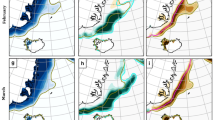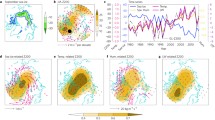Abstract
A seasonal energy balance climate model containing a detailed treatment of surface and planetary albedo, and in which seasonally varying land snow and sea ice amounts are simulated in terms of a number of explicit physical processes, is used to investigate the role of high latitude ice, snow, and vegetation feedback processes. Feedback processes are quantified by computing changes in radiative forcing and feedback factors associated with individual processes. Global sea ice albedo feedback is 5–8 times stronger than global land snowcover albedo feedback for a 2% solar constant increase or decrease, with Southern Hemisphere cryosphere feedback being 2–5 times stronger than Northern Hemisphere cryosphere feedback.
In the absence of changes in ice extent, changes in ice thickness in response to an increase in solar constant are associated with an increase in summer surface melting which is exactly balanced by increased basal winter freezing, and a reduction in the upward ocean-air flux in summer which is exactly balanced by an increased flux in winter, with no change in the annual mean ocean-air flux. Changes in the mean annual ocean-air heat flux require changes in mean annual ice extent, and are constrained to equal the change in meridional oceanic heat flux convergence in equilibrium. Feedback between ice extent and the meridional oceanic heat flux obtained by scaling the oceanic heat diffusion coefficient by the ice-free fraction regulates the feedback between ice extent and mean annual air-sea heat fluxes in polar regions, and has a modest effect on model-simulated high latitude temperature change.
Accounting for the partial masking effect of vegetation on snow-covered land reduces the Northern Hemisphere mean temperature response to a 2% solar constant decrease or increase by 20% and 10%, respectively, even though the radiative forcing change caused by land snowcover changes is about 3 times larger in the absence of vegetational masking. Two parameterizations of the tundra fraction are tested: one based on mean annual land air temperature, and the other based on July land air temperature. The enhancement of the mean Northern Hemisphere temperature response to solar constant changes when the forest-tundra ecotone is allowed to shift with climate is only 1/3 to 1/2 that obtained by Otterman et al. (1984) when the mean annual parameterization is used here, and only 1/4 to 1/3 as large using the July parameterization.
The parameterized temperature dependence of ice and snow albedo is found to enhance the global mean temperature response to a 2% solar constant increase by only 0.04 °C, in sharp contrast to the results of Washington and Meehl (1986) obtained with a mean annual model. However, there are significant differences in the method used here and in Washington and Meehl to estimate the importance of this feedback process. When their approach is used in a mean annual version of the present model, closer agreement to their results is obtained.
Similar content being viewed by others
References
Briegleb, B. and Ramanathan, V.: 1982, ‘Spectral and Diurnal Variations in Clear Sky Planetary Albedo’, J. Appl. Meteor. 21, 1160–1171.
Crutcher, H. L. and Meserve, J. M., 1970: Selected Level Heights, Temperatures, and Dew Points for the Northern Hemisphere, NAVAIR 50-1C-52, Chief Nav. Op., Washington.
Dickinson, R. E., Meehl, G. A., and Washington, W. M., 1987: ‘Ice-albedo Feedback in a CO2doubling Simulation’, Clim. Change 10, 241–248.
Foster, T. D. and Middleton, J. H.: 1980, ‘Bottom Water Formation in the Western Weddell Sea’, Deep Sea Res. 27A, 367–381.
Hare, F. K. and Hay, J. E.: 1974, ‘The Climate of Canada and Alaska’, in Bryson, R. A. and Hare, F. K. (eds.), The Climates of North America, World Survey of Climatology, Vol. 11, Elsevier, pp. 49–192.
Harvey, L. D. D.: 1988a, ‘A Semi-analytic Energy Balance Climate Model with Explicit Sea Ice and Snow Physics’, J. Clim. (in press).
Harvey, L. D. D.: 1988b, ‘Development of a Sea Ice Model for Use in Zonally Averaged Energy Balance Climate Models’, J. Clim. (in press).
Harvey, L. D. D.: 1988c, ‘Milankovitch Theory, Interhemispheric Differences in Climate Sensitivity, and North Atlantic Bottom Water Formation’, (in prep.).
Hibler, W. D.: 1980, ‘Modeling a Variable Thickness Sea Ice Cover’, Mon. Wea. Rev. 108, 1943–1973.
Imbrie, J. and Imbrie, J. Z.: 1980, ‘Modeling the Climatic Response to Orbital Variations’, Science 207, 943–953.
Johnson, R. G. and Andrews, J. T.: 1979, ‘Rapid Ice-sheet Growth and Initiation of the Last Glaciation’, Quat. Res. 12, 119–134.
Manabe, S. and Stouffer, R. J.: 1980, ‘Sensitivity of a Global Climate Model to an Increase of CO2 Concentration in the Atmosphere’, J. Geophys. Res. 85, 5529–5554.
Manabe, S. and Wetherald, R. T.: 1967, ‘Thermal Equilibrium of the Atmosphere with a Given Distribution of Relative Humidity’, J. Atmos. Sci. 24, 241–259.
Mercer, J. H.: 1984, ‘Simultaneous Climatic Change in Both Hemispheres and Similar Bipolar Interglacial Warming: Evidence and Implications’, in Hansen, J. E., and Takahashi, T. (eds.), Climate Processes and Climate Sensitivity (Maurice Ewing Series, No. 5), American Geophysical Union, Washington, pp. 307–313.
Milankovitch, M. M.: 1941, Canon of Insolation and the Ice Age Problem, Beograd, Koniglich Serbische Akademie. English translation by the Israel Program for Scientific Translations, published for the National Science Foundation, Washington, D.C. (1969).
Otterman, J., Chou, M.-D., and Arking, A.: 1984, ‘Effects of Nontropical Forest Cover on Climate’, J. Clim. Applied Meteor. 23, 762–767.
Parkinson, C. L. and Washington, W. M.: 1979, ‘A Large-Scale Numerical Model of Sea Ice’, J. Geophys. Res. 84, 311–337.
Pollard, D.: 1983, ‘A Coupled Climate-Ice Sheet Model Applied to the Quaternary Ice Ages’, J. Geophys. Res. 88, 7705–7718.
Robock, A.: 1983, ‘Ice and Snow Feedbacks and the Latitudinal and Seasonal Distribution of Climate Sensitivity’, J. Atmos. Sci. 40, 986–997.
Schlesinger, M. E.: 1985, ‘Analysis of Results from Energy Balance and Radiative-convective Models’, in MacCracken, M. C. and Luther, F. M. (eds.), Projecting the Climatic Effects of Increasing Carbon Dioxide, U.S. Dept. Energy, DOE/ER-0237, Washington, pp. 281–319.
Schlesinger, M. E. and Mitchell, J. F. B.: 1985, ‘Model Projections of the Equilibrium Climatic Response to Increased Carbon Dioxide’, in MacCracken, M. C. and Luther, F. M. (eds.), Projecting the Climatic Effects of Increasing Carbon Dioxide, U.S. Dept. Energy, DOE/ER-0237, Washington, pp. 81–147.
Semtner, A. J.: 1976, ‘A Model for the Thermodynamic Growth of Sea Ice in Numerical Investigations of Climate’, J. Phys. Oceanogr. 6, 379–389.
Short, D. A., North, G. R., Bless, T. D., and Smith, G. L.: 1984, ‘Infrared Parameterization and Simple Climate Models’, J. Clim. Applied Meteor. 23, 1222–1233.
Spelman, M. J. and Manabe, S.: 1984, ‘Influence of Oceanic Heat Transport upon the Sensitivity of a Model Climate’, J. Geophys. Res. 89, 571–586.
Thompson, S. L. and Warren, S. G.: 1982, ‘Parameterization of Outgoing Infrared Radiation Derived from Detailed Radiative Calculations’, J. Atmos. Sci. 39, 2667–2680.
Washington, W. M. and Meehl, G. A.: 1986, ‘General Circulation Model CO2 Sensitivity Experiments: Snow-Sea Ice Albedo Parameterization and Globally Averaged Surface Air Temperature’, Clim. Change 8, 231–241.
Author information
Authors and Affiliations
Rights and permissions
About this article
Cite this article
Harvey, L.D.D. On the role of high latitude ice, snow, and vegetation feedbacks in the climatic response to external forcing changes. Climatic Change 13, 191–224 (1988). https://doi.org/10.1007/BF00140569
Received:
Revised:
Issue Date:
DOI: https://doi.org/10.1007/BF00140569




